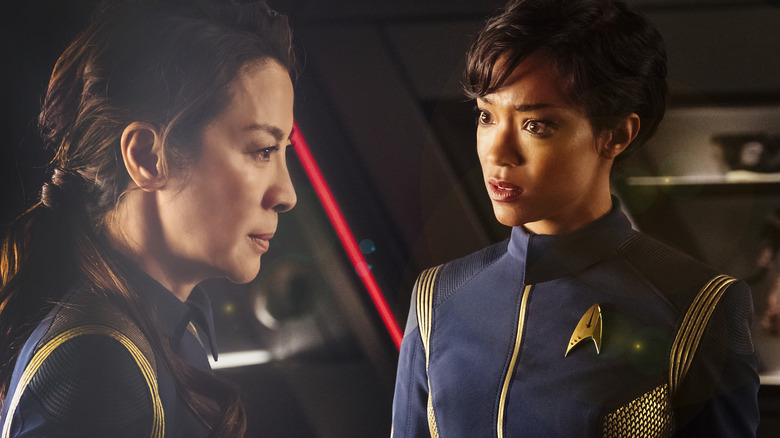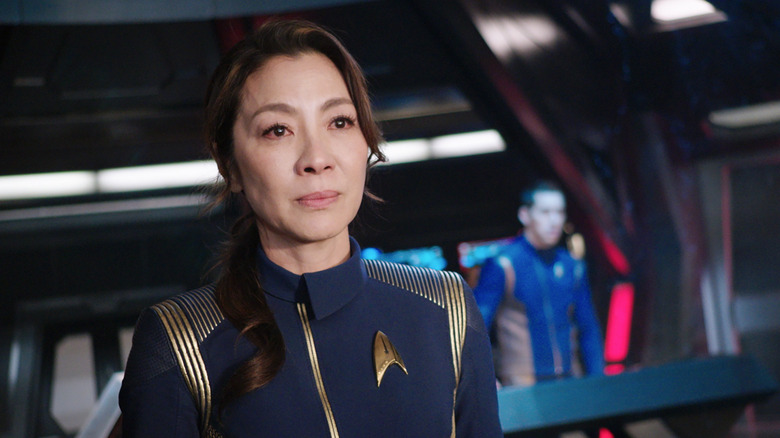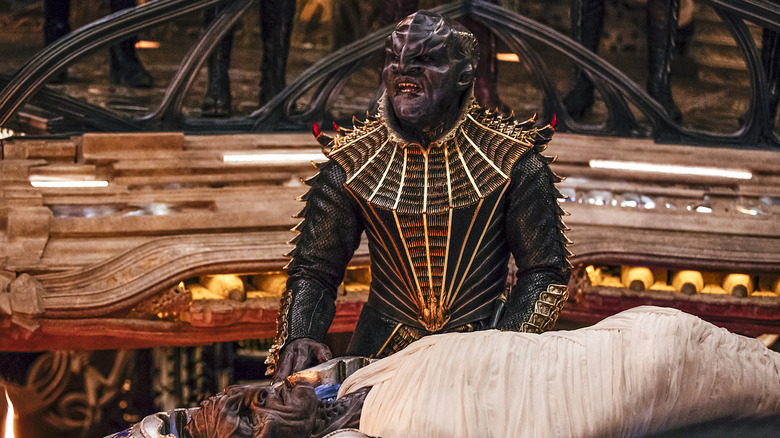The story of the making of “Star Trek: Discovery” is well-known to Trekkies with a smattering of inside-baseball data. Bryan Fuller was requested to create a brand new “Star Trek” sequence by the higher-ups at CBS, and he was keen to take action. He liked “Star Trek,” having written scripts for “Star Trek: Deep House 9” and “Star Trek: Voyager.” He and Alex Kurtzman started assembling a brand new sequence, as CBS did not but have an concept of what they needed. Fuller had a novel concept: a “Star Trek” anthology sequence. He envisioned a sequence of a number of 10-episode seasons, each set at a special time throughout the future historical past of “Star Trek.” The primary season would happen shortly earlier than the occasions of the unique “Star Trek,” the second would run concurrently with the unique “Star Trek,” the third throughout the age of “Star Trek: The Subsequent Era,” and so forth, ending within the distant, distant future.
Expectations had been excessive, and numerous CBS muckety-mucks needed to get their fingers within the pie. Fuller saved butting heads with CBS. It was a tough gig. What’s extra, Fuller was unfold skinny, additionally serving because the showrunner on “American Gods,” so it was tough throughout. Finally, Fuller introduced in a couple of co-showrunners shortly earlier than being requested to go away. Different showrunners finally entered the scene, and “Discovery” was developed with out his enter. Solely a few of what Fuller invented went into the ultimate present.
A few of what remained is detailed beneath, however a latest interview with the podcast The D-Con Chamber, handily transcribed by Inverse, has revealed much more of Fuller’s unique concepts for the primary time. He even revealed sure members of the solid he had been eyeballing.
Captain Gillian Anderson and Klingon Laurence Fishburne had been on the docket
Plainly casting was nonetheless underway when Fuller was taken off the “Discovery” undertaking. He revealed that Sarek, Spock’s father, was to play a component a lot earlier within the sequence and that he needed actor Richard Armitage to play the character. One would possibly know him as Thorin from Peter Jackson’s “Hobbit” films, though he has had fairly a prolific profession. Sarek, after all, ended up showing within the second season of “Discovery,” and was performed by James Frain.
Most excitingly, Fuller revealed two large stars he was gunning for. “Gillian Anderson was going to play a Starfleet captain,” he mentioned. Additionally, he needed “Laurence Fishburne as a Klingon.” Anderson, after all, is understood to sci-fi followers of the Nineteen Nineties as Dana Scully from “The X-Recordsdata,” giving her nerd cred, however she has additionally gained an excessive amount of popularity of her roles on “Intercourse Training” and, more recently, “The Crown.” She’s additionally labored with Fuller on his TV sequence “Hannibal,” as did Fishburne. There was each cause to consider he would have the ability to persuade them to star on “Star Trek: Discovery.” This information is probably going making Trekkies squirm with disappointment on the missed alternatives.
He additionally commented that the short-tempered engineer Paul Stamets was initially going to be performed by Wilson Cruz, whereas Stamets’ husband, Dr. Hugh Culber, was going to be performed by Anthony Rapp. Within the last model of the present, the roles had been reversed. Oh sure, and Culber was initially envisioned as an Andorian, the blue-skinned, white-haired species with antennae.
It is onerous to say why these casting concepts weren’t applied, though one might theorize that Fishburne and Anderson would have been costly hires.
Fuller hated the uniforms and the Klingons that Discovery went with
The casting of Michelle Yeoh, it appears, was Fuller’s concept. She performed Captain Georgiou, later killer and changed by an evil doppelgänger from a parallel universe. The evil Empress Georgiou not too long ago appeared within the TV film “Star Trek: Part 31.” It wasn’t well-received. Fuller doesn’t settle for blame for a few of the extra controversial parts of “Star Trek: Discovery,” saying that, “On my final week, I accredited the Starfleet uniforms, which they tossed out, and rejected the Klingons, which they saved.”
The uniforms on “Discovery” had been, in contrast to extra recognizable Starfleet uniforms, full-body blue jumpsuits trimmed with gold, silver, or bronze, relying on the officer’s division. They had been okay-looking uniforms, however they did not scream “Star Trek.” Extra extensively hated was an notorious redesign of the Klingons. The species was given new outsize heads, massive monster claws, and extraneous nostrils. Additionally, they’d no hair, and their pores and skin went from a extra pure human tone to both jet black, sickly grey, or milk white. The Klingon design was so extensively hated that the brand new “Discovery” showrunners started fleeing from it within the second season. By the times of “Star Trek: Unusual New Worlds,” the Klingons seemed much more like they did within the Nineteen Nineties.
“Discovery” is not as well-liked as most of the different “Star Trek” exhibits, and it clearly suffers from having manner too many producers within the room (every episode credit not less than 20). After 5 seasons, it has come to an finish, and the present sort of — kiiind of — caught with Fuller’s anthology idea by skipping ahead in time firstly of its third season. The truth that “Discovery” is a violent motion sequence with common murders feels extra like Kurtzman’s doing.
The story of the making of “Star Trek: Discovery” is well-known to Trekkies with a smattering of inside-baseball data. Bryan Fuller was requested to create a brand new “Star Trek” sequence by the higher-ups at CBS, and he was keen to take action. He liked “Star Trek,” having written scripts for “Star Trek: Deep House 9” and “Star Trek: Voyager.” He and Alex Kurtzman started assembling a brand new sequence, as CBS did not but have an concept of what they needed. Fuller had a novel concept: a “Star Trek” anthology sequence. He envisioned a sequence of a number of 10-episode seasons, each set at a special time throughout the future historical past of “Star Trek.” The primary season would happen shortly earlier than the occasions of the unique “Star Trek,” the second would run concurrently with the unique “Star Trek,” the third throughout the age of “Star Trek: The Subsequent Era,” and so forth, ending within the distant, distant future.
Expectations had been excessive, and numerous CBS muckety-mucks needed to get their fingers within the pie. Fuller saved butting heads with CBS. It was a tough gig. What’s extra, Fuller was unfold skinny, additionally serving because the showrunner on “American Gods,” so it was tough throughout. Finally, Fuller introduced in a couple of co-showrunners shortly earlier than being requested to go away. Different showrunners finally entered the scene, and “Discovery” was developed with out his enter. Solely a few of what Fuller invented went into the ultimate present.
A few of what remained is detailed beneath, however a latest interview with the podcast The D-Con Chamber, handily transcribed by Inverse, has revealed much more of Fuller’s unique concepts for the primary time. He even revealed sure members of the solid he had been eyeballing.
Captain Gillian Anderson and Klingon Laurence Fishburne had been on the docket
Plainly casting was nonetheless underway when Fuller was taken off the “Discovery” undertaking. He revealed that Sarek, Spock’s father, was to play a component a lot earlier within the sequence and that he needed actor Richard Armitage to play the character. One would possibly know him as Thorin from Peter Jackson’s “Hobbit” films, though he has had fairly a prolific profession. Sarek, after all, ended up showing within the second season of “Discovery,” and was performed by James Frain.
Most excitingly, Fuller revealed two large stars he was gunning for. “Gillian Anderson was going to play a Starfleet captain,” he mentioned. Additionally, he needed “Laurence Fishburne as a Klingon.” Anderson, after all, is understood to sci-fi followers of the Nineteen Nineties as Dana Scully from “The X-Recordsdata,” giving her nerd cred, however she has additionally gained an excessive amount of popularity of her roles on “Intercourse Training” and, more recently, “The Crown.” She’s additionally labored with Fuller on his TV sequence “Hannibal,” as did Fishburne. There was each cause to consider he would have the ability to persuade them to star on “Star Trek: Discovery.” This information is probably going making Trekkies squirm with disappointment on the missed alternatives.
He additionally commented that the short-tempered engineer Paul Stamets was initially going to be performed by Wilson Cruz, whereas Stamets’ husband, Dr. Hugh Culber, was going to be performed by Anthony Rapp. Within the last model of the present, the roles had been reversed. Oh sure, and Culber was initially envisioned as an Andorian, the blue-skinned, white-haired species with antennae.
It is onerous to say why these casting concepts weren’t applied, though one might theorize that Fishburne and Anderson would have been costly hires.
Fuller hated the uniforms and the Klingons that Discovery went with
The casting of Michelle Yeoh, it appears, was Fuller’s concept. She performed Captain Georgiou, later killer and changed by an evil doppelgänger from a parallel universe. The evil Empress Georgiou not too long ago appeared within the TV film “Star Trek: Part 31.” It wasn’t well-received. Fuller doesn’t settle for blame for a few of the extra controversial parts of “Star Trek: Discovery,” saying that, “On my final week, I accredited the Starfleet uniforms, which they tossed out, and rejected the Klingons, which they saved.”
The uniforms on “Discovery” had been, in contrast to extra recognizable Starfleet uniforms, full-body blue jumpsuits trimmed with gold, silver, or bronze, relying on the officer’s division. They had been okay-looking uniforms, however they did not scream “Star Trek.” Extra extensively hated was an notorious redesign of the Klingons. The species was given new outsize heads, massive monster claws, and extraneous nostrils. Additionally, they’d no hair, and their pores and skin went from a extra pure human tone to both jet black, sickly grey, or milk white. The Klingon design was so extensively hated that the brand new “Discovery” showrunners started fleeing from it within the second season. By the times of “Star Trek: Unusual New Worlds,” the Klingons seemed much more like they did within the Nineteen Nineties.
“Discovery” is not as well-liked as most of the different “Star Trek” exhibits, and it clearly suffers from having manner too many producers within the room (every episode credit not less than 20). After 5 seasons, it has come to an finish, and the present sort of — kiiind of — caught with Fuller’s anthology idea by skipping ahead in time firstly of its third season. The truth that “Discovery” is a violent motion sequence with common murders feels extra like Kurtzman’s doing.





















